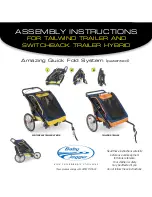
Usage instructions for NJ1 adaptive bike
14
bottom bracket in this case is selected to be
slightly higher (chest height or higher).
Sporty users with the appropriate trunk
stability
relieve their arm muscles by moving
their trunk at the same time. The height of the
bottom bracket in this case can be selected to
be slightly lower (chest height or lower).
The following points must be fulfilled for the
proper seating position:
The cranks must not touch the knee or
thigh when they are being turned.
The elbows should not be completely ex-
tended when the crank handles point com-
pletely forward away from the body.
A suitable restraint system must be used
if you have poor seating stability due to a lack
of or weak core strength. The selection of the
suitable system must be made in conjunction
with your doctor or therapist and/or defined
and implemented by your rehabilitation special-
ist dealer. There are various systems available
such as chest straps or four-point safety belts.
Rehabilitation specialist dealers can also often
create a customised system or adapt commer-
cially available systems.
Recommended equipment:
PRO ACTIV also offers restraint systems such
as hip straps with belt and Velcro fastener and
chest straps of various lengths.
19.2.2 Bottom bracket position
In a product equipped with a
non-adjustable
bottom bracket support
, a subsequent ad-
justment of the bottom bracket position can
only be achieved by exchanging the bottom
bracket support, the angle adjustment possible
on the steering head as well as the length ad-
justment and the spacing of the adapter tube
on the adaptation points on the wheelchair
frame (see usage instructions "Adapter & ad-
aptation").
The bottom bracket support can be exchanged
by loosening the four M6 fixing screws (AF
5 mm) on the tip fork bridge and the four M6
fixing screws (AF 4 mm) on the bottom bracket
housing. Then the new bottom bracket support
with another length can be inserted and the 8
fixing screws tightened up to 7 Nm and se-
cured with thread lock fluid. Finally, check the
chain length and the cable lengths and adjust
them if necessary.
Figure 12: M6 fixing screws on the top fork bridge
Figure 13: M6 fixing screws on the bottom bracket
housing
If your product is fitted with an
adjustable
bottom bracket support (optional)
, the bot-
tom bracket position can be adjusted in angle
and height:
The
angle
is adjusted at the top fork
bridge. To do this, loosen the four M6
clamp screws (AF 5 mm), on the clamp
slightly so that the bottom bracket sup-
port's angle can be adjusted using minimal
force. The angle adjustment is continuous
(as a guide, there is a 12° scale fitted).
When you have finished adjusting the an-
gle, tighten up the four M6 clamp screws
M6 fixing screws
on the bottom
bracket housing
M6 fixing screws on
the top fork bridge
















































